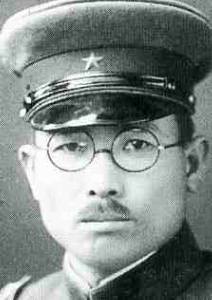Isamu Chō facts for kids
Quick facts for kids
Isamu Chō
|
|
|---|---|
 |
|
| Born | 19 January 1895 Fukuoka, Japan |
| Died | 22 June 1945 (aged 50) Okinawa, Japan |
| Allegiance | |
| Service/ |
|
| Years of service | 1913–1945 |
| Rank | |
| Commands held | 10th Infantry Division |
| Battles/wars | Second Sino-Japanese War World War II |
Isamu Chō (長 勇, Chō Isamu, 19 January 1895 – 22 June 1945) was an officer in the Imperial Japanese Army. He was known for his strong belief in Japanese nationalism. He was also involved in several attempts to change the government before World War II.
Contents
Isamu Chō: Early Life and Military Career
Chō was born in Fukuoka prefecture, Japan. He joined the military at a young age. He graduated from the Imperial Japanese Army Academy in 1913. Later, he completed his studies at the Army Staff College in 1928.
After becoming an officer, Chō was sent to China. He served with the Kwantung Army there. This army was known for its political influence.
Involvement in Japanese Politics
Chō returned to Japan and became very active in politics within the army. He was part of several events that tried to change the government. These included the March Incident and the Imperial Colors Incident.
He also helped start a secret group called "Sakurakai". This group wanted to replace the democratic government. They aimed for a totalitarian system. This new system would have total control and try to stop corruption.
Military Service in China and World War II
When the Second Sino-Japanese War began, Chō was a commander. He led the IJA 74th Infantry Regiment. This unit was part of the Shanghai Expeditionary Force. They were based in Manchukuo.
Role in the Battle of Nanjing
During the Battle of Nanjing, Chō was an aide-de-camp to Prince Asaka. An aide-de-camp is like a personal assistant to a high-ranking officer. Chō is believed to have been involved in ordering the Nanjing Massacre. However, it is debated if he followed orders from the prince or acted on his own.
Border Conflicts and Strategic Planning
From 1939 to 1940, Chō was the Chief of Staff for the IJA 26th Division. He was involved in conflicts between Manchukuo and the Soviet Union.
Later, he became the Chief of Staff for the Indochina Expeditionary Army. This was from 1940 to 1941. In 1941, he helped plan the Japanese invasion of Southeast Asia.
From 1942 to 1944, Chō commanded the 10th Infantry Group. This group was a garrison force in Manchukuo. A garrison force is a group of soldiers stationed in a particular place to defend it. He also served at the Kwantung Army Headquarters.
The Battle of Okinawa
In late 1944, Chō was sent to Okinawa. He became the Chief of Staff for the 32nd Army. This was during the Battle of Okinawa.
He planned the complex underground defenses around Shuri Castle. Chō believed in fighting aggressively against the American invasion. He did not want a passive defense. He convinced General Mitsuru Ushijima to launch a counteroffensive on May 5, 1945. This attack, however, did not go well.
By mid-June, the 32nd Army had only two strong positions left. One was under Kunishi Ridge, and the other was their headquarters inside Hill 89.
Chō died on June 22, 1945. He had written a poem on the back of his kimono:
“With bravery I served my nation.
With loyalty I dedicate my life.”

